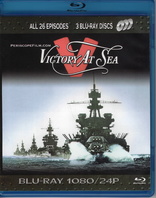Victory at Sea Blu-ray Movie
HomeVictory at Sea Blu-ray Movie 
Deluxe EditionPeriscope Film | 1952-1953 | 683 min | Not rated | Nov 23, 2010
Movie rating
7.4 | / 10 |
Blu-ray rating
| Users | 4.0 | |
| Reviewer | 4.0 | |
| Overall | 4.0 |
Overview
Victory at Sea (1952-1953)
Leonard Graves narrates this gripping 26-part documentary, which debuted in 1952, about World War II and how it was waged from all fronts — on the ground, from the skies and, most of all, on the sea. Extensive black-and-white footage of the battles and remarkably balanced commentary take viewers right to the front lines.
Starring: Dwight D. Eisenhower, Winston Churchill, Hermann Göring, Franklin D. Roosevelt, Erwin RommelNarrator: Leonard Graves
Director: M. Clay Adams
| War | Uncertain |
| History | Uncertain |
| Documentary | Uncertain |
Specifications
Video
Video codec: MPEG-4 AVC
Video resolution: 1080p
Aspect ratio: 1.37:1
Original aspect ratio: 1.37:1
Audio
English: Dolby Digital 2.0 (192 kbps)
Subtitles
None
Discs
50GB Blu-ray Disc
Three-disc set (3 BDs)
Playback
Region free
Review
Rating summary
| Movie | 4.0 | |
| Video | 3.0 | |
| Audio | 2.5 | |
| Extras | 3.0 | |
| Overall | 4.0 |
Victory at Sea Blu-ray Movie Review
This epic NBC series helped establish the documentary form as a staple of television.
Reviewed by Jeffrey Kauffman November 24, 2010Television was still very much a new fangled contraption in 1952 and 1953. While more and more people were bringing the giant sets with the tiny screens home and enjoying everything from Uncle Miltie to I Love Lucy, there was still something special about being able to see moving pictures over the air, free and in the comfort of your own home. The major networks were still trying to figure out exactly what kinds of shows they should program and it may therefore be something of a surprise to realize that the now famous war documentary Victory at Sea was something of a major risk when NBC decided to program it on Sunday afternoons starting in the fall of 1952. Something of this extended length and scope had never really been attempted before on American television, and there was a certain trepidation that a long form documentary series was not something the American public would flock to, even with the newness still attached to the television medium as a whole. NBC needn’t have worried. Victory at Sea attracted large and appreciative audiences and the epic recounting of America’s naval involvement in World War II became an early harbinger of just what television could accomplish should it set its mind to do something more than present a cross-dressing comedian or, indeed, a cross-dressing comedienne. Some 20 years before The World at War fascinated a new generation of WWII enthusiasts (if that’s the right word), Victory at Sea enthralled audiences with its 26 episode recounting of everything from Pearl Harbor to the Atom Bomb. Conceived by a sailor named Henry Salomon, Victory at Sea was one of the first television documentaries to effectively exploit the millions of feet of footage shot by various newsreels and actual combatants in and around the war. While that kept filming costs relatively low, it made for an exhaustive research project and in fact it took around two years for Victory at Sea to be assembled into a final product. NBC was taking no chances, however, and in a sort of odd marketing decision decided that the name of Broadway’s leading composer Richard Rodgers could help attract audiences to the project. Rodgers was hired to ostensibly score the entire series (and in fact he received a composer credit). What Rodgers actually did was to sketch out 12 very brief piano themes which his regular orchestrator Robert Russell Bennett then developed into a huge, virtually thirteen hour through-scored orchestral suite which accompanied each of the 26 half hour long episodes. Long after Victory at Sea had receded in viewers’ memories, albums (and later CDs) of the score of the show were a staple at record emporiums around the world.
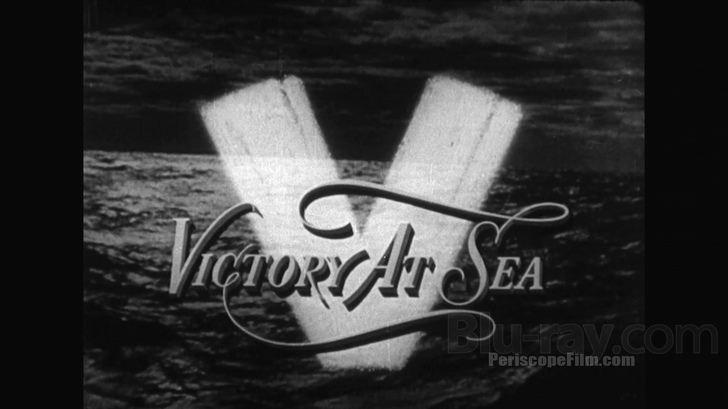
Victory at War’s focus is considerably more limited than its progeny The World at War, concentrating as it does on the sea-born battles of World War II. Even with that caveat, this is about as comprehensive a look at the naval and marine sides of things as could reasonably be expected from a production still this temporally close to the actual battle. The series actually does give us some pre-Pearl Harbor background in the first episode, “Design for War,” which doesn’t spend a lot of time analyzing Hitler’s rise to power and its socioeconomic causes, but instead leaps headlong into Germany’s invasion of Poland and France. The oceanic focus is maintained by dealing with Lend-Lease and the Germans’ initial successes with U-boats.
Starting with the second episode, “The Pacific Boils Over,” we move on to actual American involvement in the melee, after the devastating attack on Pearl Harbor. Victory at Sea spends the next 25 episodes doing a very thorough job of visiting both major arenas like Midway and Guadalcanal while also spending individual episodes on other tangential issues like establishing supply lines. If Victory at Sea eschews the first person narrative style which made The World at War such a viscerally compelling piece of documentary filmmaking, it nevertheless manages to engage viewer interest with an unending series of mostly well chosen stock, newsreel and battle footage which does in fact put the viewer squarely in the middle of things. Astute historians will no doubt quibble about some of this footage, which is obviously not culled from the actual battles, or even correct timeframes, but the overall impact, while somewhat dated, cannot be denied.
Victory at Sea was made in a less politically correct time, and tensions were still obviously not complete quelled despite the war having been over for some seven years by the time the show aired, therefore Leonard Graves’ narration may strike some as insensitive with its allusions to “Japs” and “Huns” and other terms of the trade from that era. There’s little self-reflection in this series, and instead the documentary starts with the fundamental and inarguable (by its own standards) premise that the United States and its allies were the good guys and vanquishing the evil Axis powers was doing the work of angels. It may strike some as naïve, even politically at least partially less than nuanced, but Victory at Sea is a product of its time, full of the early 1950s ambience which combined a certain sanguine quality mixed with, strangely enough, a growing paranoia.
This epic series has a spotty copyright history, with both NBC and CBS associated entities claiming various rights. The actual series fell into the public domain years ago and a slew of PD VHS, DVD and laserdisc versions have appeared through the years. These have been of varying quality, none of them very good. Periscope Films has taken the time to restore the series, as much as it can be, transferring it to HD with a fair amount of finesse. If the results are far from pristine, due to a variety of factors, not the least of which is the hugely variant quality of the source elements themselves, this is easily the best looking Victory at Sea has ever been in a home video format. There are some minor quibbles I have with this release, discussed below in the video and audio sections of the review, but Periscope is to be commended for taking the time, effort (and of course money) to revisit these historically important videos of yore and sprucing them up for modern audiences.
The 26 episodes included on this 3 BD set are:
Design for War: Battle of the Atlantic, 1939-1941
The Pacific Boils Over: Pearl Harbor, December 7, 1941
Sealing the Breach: Anti-submarine Warfare, 1941-1943
Midway is East: Western Pacific and the Battle of Midway
Mediterranean Mosaic: Gibraltar, Allied and Enemy Fleets, Malta
Guadalcanal: Guadalcanal
Rings Around Rabaul: Struggle for the Solomon and Admiralty Islands
Mare Nostrum: Command of the Mediterranean, 1940-1942
Sea and Sand: Invasion of North Africa, 1942-1943
Beneath the Southern Cross: War in the South Atlantic
The Magnetic North: War from Murmansk to Alaska
The Conquest of Micronesia: Carrier warfare and the Gilberts and Marshalls
Melanesian Nightmare: New Guinea Campaign
Roman Renaissance: Sicily and the Italian Campaign, South of France
D-Day: Normandy
Killers and the Killed: Victory in the Atlantic, 1943-1945
The Turkey Shoot: Conquest of the Marianas
Two if by Sea: Peleliu and Angaur
Battle for Leyte Gulf: Leyte Landings and the Battle for Leyte Gulf
Return of the Allies: Liberation of the Philippines, South China Sea and Borneo
Full Fathom Five: U.S. Submarines Against Japan, 1941-1945
The Fate of Europe: Black Sea, South of France, Near East, Berlin
Target Suribachi: Battle of Iwo Jima
The Road to Mandalay: China, Burma, India and Indian Ocean
Suicide for Glory: Okinawa
Design for Peace: Surrender of Japan and Aftermath of War
Victory at Sea Blu-ray Movie, Video Quality 
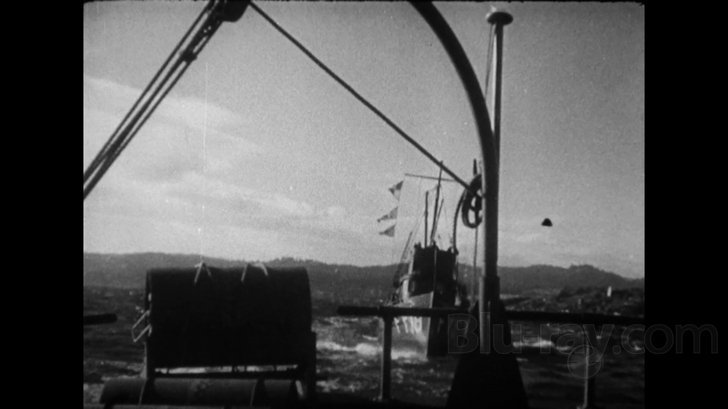
There's little doubt that Periscope Films indulged in a labor of love by transferring original film elements to HD and encoding them via AVC to provide Victory at Sea a full 1080p treatment in its original aspect ratio of 1.37:1. That said, these restoration efforts can only do so much with a lot of footage that was shot under less than optimal conditions, never stored properly, and was on substandard stock to begin with, often in very small 8mm or 16mm formats. Therefore anyone expecting a miracle with this new Blu-ray release is probably going to be sorely disappointed. However, a quick comparison to any of the many previous home video releases (and Periscope kindly provided me with a PD DVD release of the title just for those purposes) proves that there is a considerable uptick in both sharpness and especially contrast in this new release. Does it look pristine? Hardly. Is there still damage? Yes, lots of it. There's also overwhelming grain, especially in the smaller millimeter formats, but if you take all of this into consideration, this is still a very good looking release. Some of the less damaged, well shot footage in fact looks as good as anything that went through the massive restoration, scrubbing process that recently greeted The World at War. While this release is nowhere near that exhaustive in its restoration efforts, it still reveals a wealth of new detail and is especially impressive in its increased contrast. If you come to this release with realistic expectations, you'll most likely be pleasantly surprised.
Caveat: As with their previous Memphis Belle release, Periscope has chosen to "protect" its version of this PD release by burning in a "bug" (a small icon and/or text) which appears with distressing regularity in the bottom right of the image. It's not completely distracting, but it's annoying enough that it deserves mention. While it's certainly understandable why Periscope had to do this, that doesn't make it any easier to watch, however peripherally.
Victory at Sea Blu-ray Movie, Audio Quality 
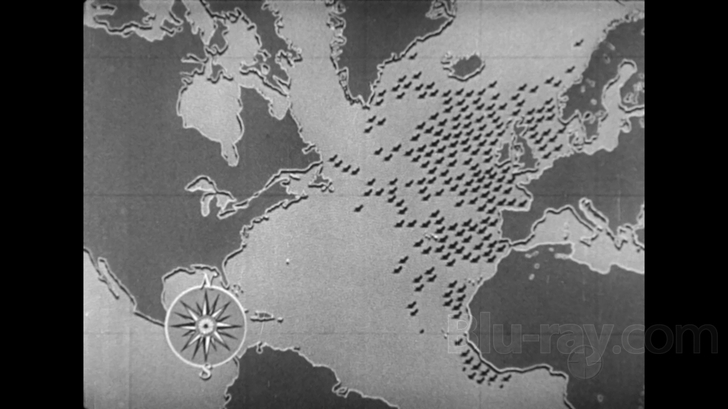
The press release which accompanied this Blu-ray was honest enough to admit that it simply wasn't feasible to provide Victory at Sea with a repurposed surround track. This series was obviously recorded in the mono age, and only a mono stem survives. The Dolby 2.0 mono track is acceptable, nothing more, but the press release does not address why we weren't at least given the option of a lossless mono LPCM 2.0 track. That would have upped the appeal of this piece immensely, which features one of the most famous scores in the history of television. As it stands, Victory at Sea sounds decent enough, though it is plagued by boxiness, some dropouts, wobble and out of phase elements. There are occasional noticeable differences in amplitude and quality can vary from episode to episode and even within certain episodes. A major restoration effort may have been cost prohibitive for a boutique label like Periscope, but a series with this iconic of a soundtrack really deserves that restoration, no matter how costly. This DD mono track gets the job done—Graves' narration and the frequent sound effects are listenable and discernable despite occasional damage, but that great Rodgers-Bennett score really would have benefited from a lossless approach.
Victory at Sea Blu-ray Movie, Special Features and Extras 
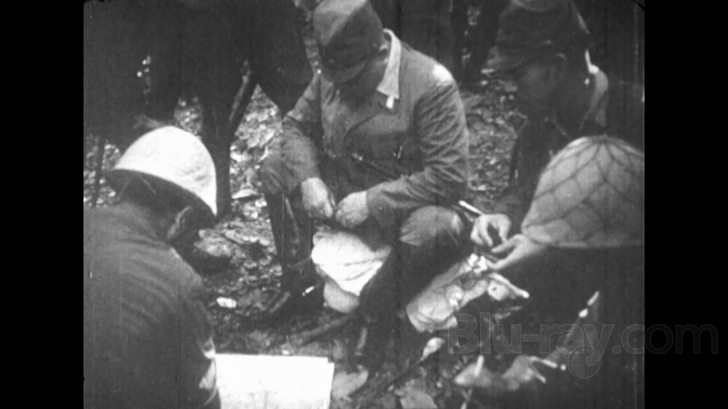
The first disc contains a PDF File of the original NBC publicity booklet from 1952. Disc One also contains an optional commentary on the "Guadalcanal" episode by Victory at Sea expert Dr. Peter C. Rollins, who despite being obviously unaccustomed to a commentator status imparts a good deal of information about the series as a whole and this particular episode. Periscope's Nick Spark also conducts an interesting audio only interview with Rollins (35:36) on Disc Three.
Victory at Sea Blu-ray Movie, Overall Score and Recommendation 

Victory at Sea is one of the most honored and beloved documentary series in television history, having won both the Emmy and the Peabody Award. While it may seem dated in certain respects to modern audiences, it is a fascinating historical time capsule both as a recounting of the naval side of World War II, but tangentially as a document of how America was feeling about the war in the early 1950s. This Periscope release has gussied up the image to a remarkable extent, but the lossy Dolby soundtrack has a number of damage issues, unfortunately. Still and all, this is the best looking and sounding this landmark series has ever been on home video, and it comes Recommended.
Similar titles
Similar titles you might also like
(Still not reliable for this title)

The World at War
1973

WWII in HD
World War II in HD
2009

Apocalypse: World War II
2010

They Shall Not Grow Old
2018

Emperor
2012

The World Wars
2014

WWII From Space
2012

The War
2007

Vietnam in HD
2011

Korengal
2014

The Vietnam War
2017

D-Day: Normandy 1944 4K
75th Anniversary Edition
2014

The Tuskegee Airmen
1995

Restrepo
2010

Fat Man and Little Boy
1989

Gettysburg
2011

A Bridge Too Far
1977

Ken Burns: The Civil War
1990

Apocalypse: Hitler
Apocalypse: The Rise of Hitler
2011

Ultimate Civil War
150th Anniversary Edition
2012
